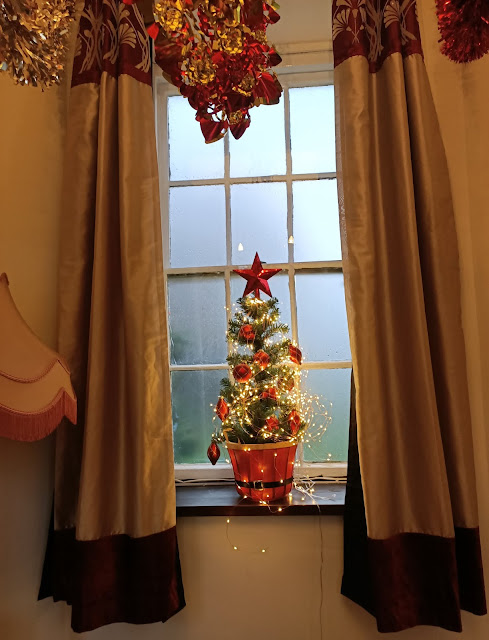 |
| Verbena bonariensis amongst seed heads of Allium aflatuense and Polemonium |
What a peculiar summer!
2019 continues to bathe the gardens at Betley Court with glorious sunshine one
day, and heavy rain the next. Today is a rain-soaked day, so I am glad I made
the best of yesterday’s clement weather and spent time on the flowerbeds. I was
joined in the gardens by a family of buzzards. Each year, a breeding pair nest
in one of the veteran oak trees on the farm next door. The chicks have now
fledged, and the family circle over the paddock, calling to each other. The
fledglings are honing their hunting skills, before they leave mum and dad to
start independent lives.
 |
| The bees' favourite and mine, Dahlia 'Bishop of Llandaff' |
Our insect population are
enjoying the flowers of high summer. Current favourites are the Verbena
bonariensis and Russian sage. And of course, the Dahlia ‘Bishop of Llandaff’
continue to keep the bees happy. The zinnias 'Queen red lime' I grew from seed are flowering,
but I must be honest, looked better on the seed company’s photos than in reality.
 |
| Zinnia 'Queen Red Lime' - not enough lime for my liking |
Elsewhere in the gardens,
our specialist contractors are now repairing the overflow on the dam. We have another
firm busy making repairs to the roof, heralded by the arrival of a ‘cherry
picker’, a mechanical lift that enables the contractors to hover over the roof
at impressive angles. Much safer than ladders! With all this rain, I’m glad
someone is attending to our Georgian roof. Rain water always succeeds in
showing up the weak points under the slates.
It always astounds me what
you can get for free, if you know where to look. The internet is a great tool
when sourcing materials. A garden the size of Betley Court’s consumes bricks,
plants and stones in unbelievable quantities. We bought in a huge amount of
sandstone at the beginning of the project for repairs to walls and path edging.
It’s all been used now, however, I have found an alternative supply of
sandstone, free to collectors. We’ve scrumped several former rockeries from grateful
householders, and a couple of trailer-loads from a guy who is creating
carparking, and kept digging up good sized stones as he was levelling. Well, if
it stops the stone ending up in landfill, I recon it’s a good thing!
 |
| This pile of sandstone used to be someone's rockery - we saved it from landfill and it is now valuable edging material |
Talking of ‘free stuff’ Nigel
and I were lucky enough to attend a free ‘Green Angels’ event over the weekend. It
was organised by our local ranger team, who look after several sites,
including the Salt Line bridleway and Brereton Nature Reserve in Cheshire.
 |
| Brereton Nature Reserve and the Green Angels are in action |
We
were shown around by Andy, who clearly loves what he does for a living. He
explained that these sites are all post-industrial, and that whilst nature
would recolonise eventually, there are things people can do (and just as
importantly NOT do) to give nature a helping hand.
 |
| Ranger Andy leads a tour |
Whilst Betley Court Gardens do not share the problems of these former
railways, salt extraction quarries and landfills, there was such a lot we could
learn about how to manage land for wildlife. One thing that caught our interest
was the wildflower meadows they managed, and even on a damp Saturday, Andy was
able to point out unusual species, including a native bee driven to extinction
in Britain in the early 19th century that is currently being
reintroduced to the reserve. We also learned about ‘standing
deadwood’, a quite specific habitat, where logs or tree stumps of different
heights are left upright to break down naturally, rather than being tidied up.
Andy explained that 13% of invertebrate species depend on rotting wood and
plant material. Whilst a woodlouse might not thrill people in the way that the sighting of a
fox or a deer would, invertibrates have an important place in the circle of life. We
also learned how to make a ‘dead hedge’ – as the name suggests, a mound of
brush and branches. They make excellent wildlife corridors for small mammals
and birds, and host large numbers of invertebrates. Another plus, from our
point of view is, when we’re cutting back trees at Betley Court, the offcuts
become a useful material, not a waste stream to dispose of by burning or
landfill.
 |
| A 'dead hedge', crafted from brush and branch clippings |
We’ve signed up for free
courses to be held next year, and hope to be putting some of these techniques
into action in the gardens as soon as possible. I for one am looking forward to
establishing some wildflower meadows.
Finally, a nice surprise
arrived for us this week in the form of some inspirational books. Philip, one
of the longest standing members of the Betley Court community, forwarded a book
about the revival of the gardens at Sissinghurst Castle. Now, that’s a garden
restoration to only dream of emulating!
 |
| Lovely book from Philip providing inspiration from the garden resto at Sissinghurst Castle |
And Philip’s friend, Rick, a regular visitor
from Texas, also handed us two books, one for Nigel, the RSPB’s Handbook of Garden
Wildlife (rather appropriate given our weekend trip to the nature reserve), and
a more art-oriented one for me, on the art of pressed flowers.
 |
| Rick from Texas sent us this fabulous pair of books |
 |
| Who knew the humble lichen could look so striking! Must start pressing flowers! |
Thank you both.
Its lovely when you realise that the many hours of work have made an impression
on people!
Ladybird Su












Comments
Post a Comment